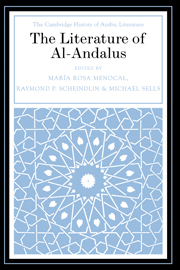4 - Spaces
from PART I - THE SHAPES OF CULTURE
Published online by Cambridge University Press: 28 May 2012
Summary
In the beginning of his account of the martyrdom of the priest Perfectus at the hands of officials of ʿAbd al-Rahmān II’s court in Córdoba, the author – and saint – Eulogius, who would soon himself be martyred, paused to contemplate the caliph’s contribution to Córdoba as a city: “since his rise to the throne, he has covered it with honor, strewn it with glory and accumulated riches, multiplied the pouring in of all the pleasures of the world, with an amplitude surpassing the imagination, of a kind that crushes in its radiance all the royal predecessors of his race in all that touches secular display, while on the other hand the orthodox church trembled under his terrible yoke”(Memoriale sanctorum 2:1, Patroligia latina vol. 115). In this expansive digression to the story of a Mozarabic martyr can be found a nod to the virtues of asceticism, but Eulogius reserves the most lavish, powerful language for the grandeur of the physical transformations of Córdoba: as he deplores the execution of the priest, Eulogius cannot help but take personal pride that the city now “crushes in its radiance all the royal predecessors.”
If there were ever a moment in the history of al-Andalus during which one would expect a cultural identity to polarize along the lines of religion, ninthcentury Córdoba of the Mozarabic martyrs would be that time, that place. This particular group of Mozarabs had resisted acculturation, had chosen nothing less than voluntary martyrdom as a kind of theater of resistance to Umayyad culture. This violent act and the Mozarabs’ nostalgia for Christian hegemony of the past, in fact, were the centerpiece for a kind of Christian cultural revival. The Mozarabic Christians feared the decimation of their traditional and historical identities in the face of the juggernaut of opulent, complex cosmopolitan literary and visual culture.
- Type
- Chapter
- Information
- The Literature of Al-Andalus , pp. 83 - 95Publisher: Cambridge University PressPrint publication year: 2000

